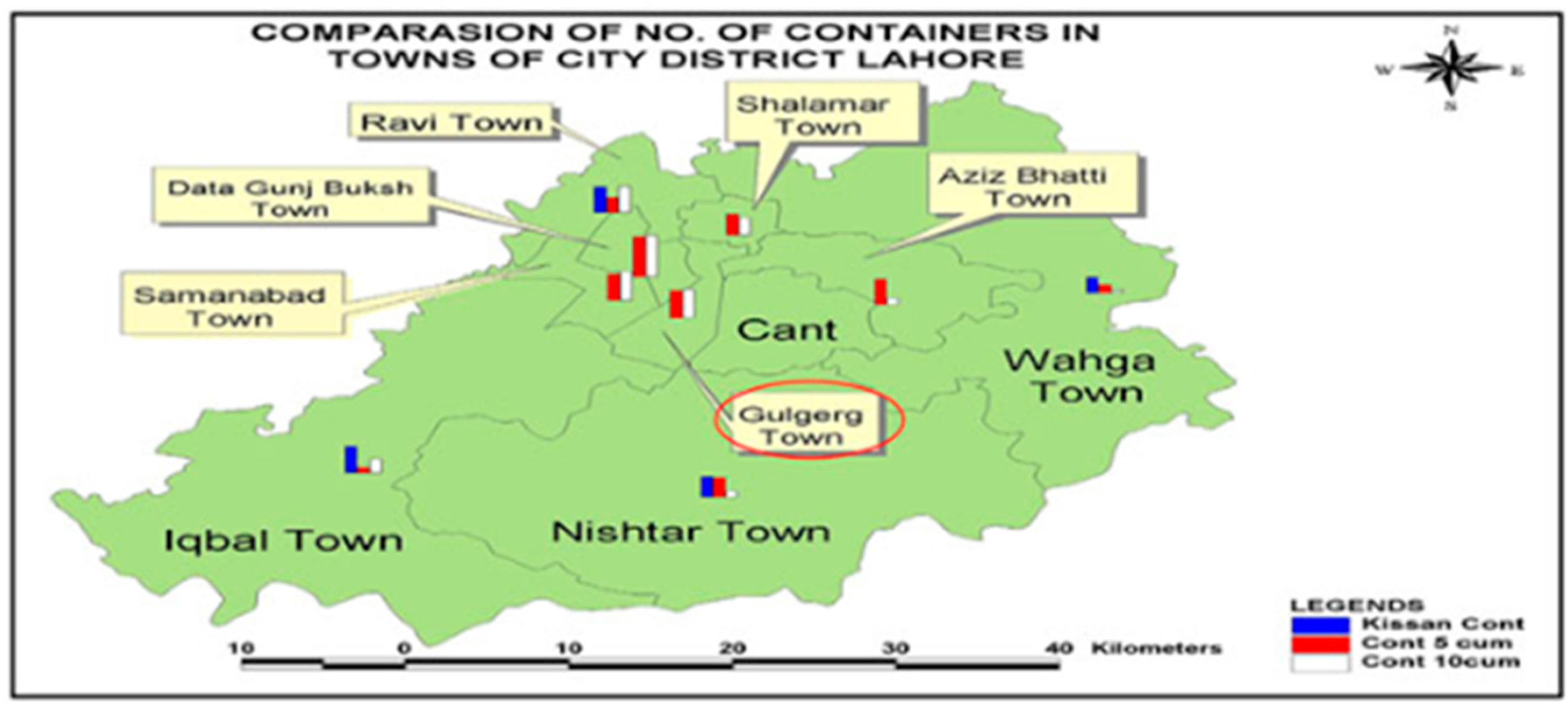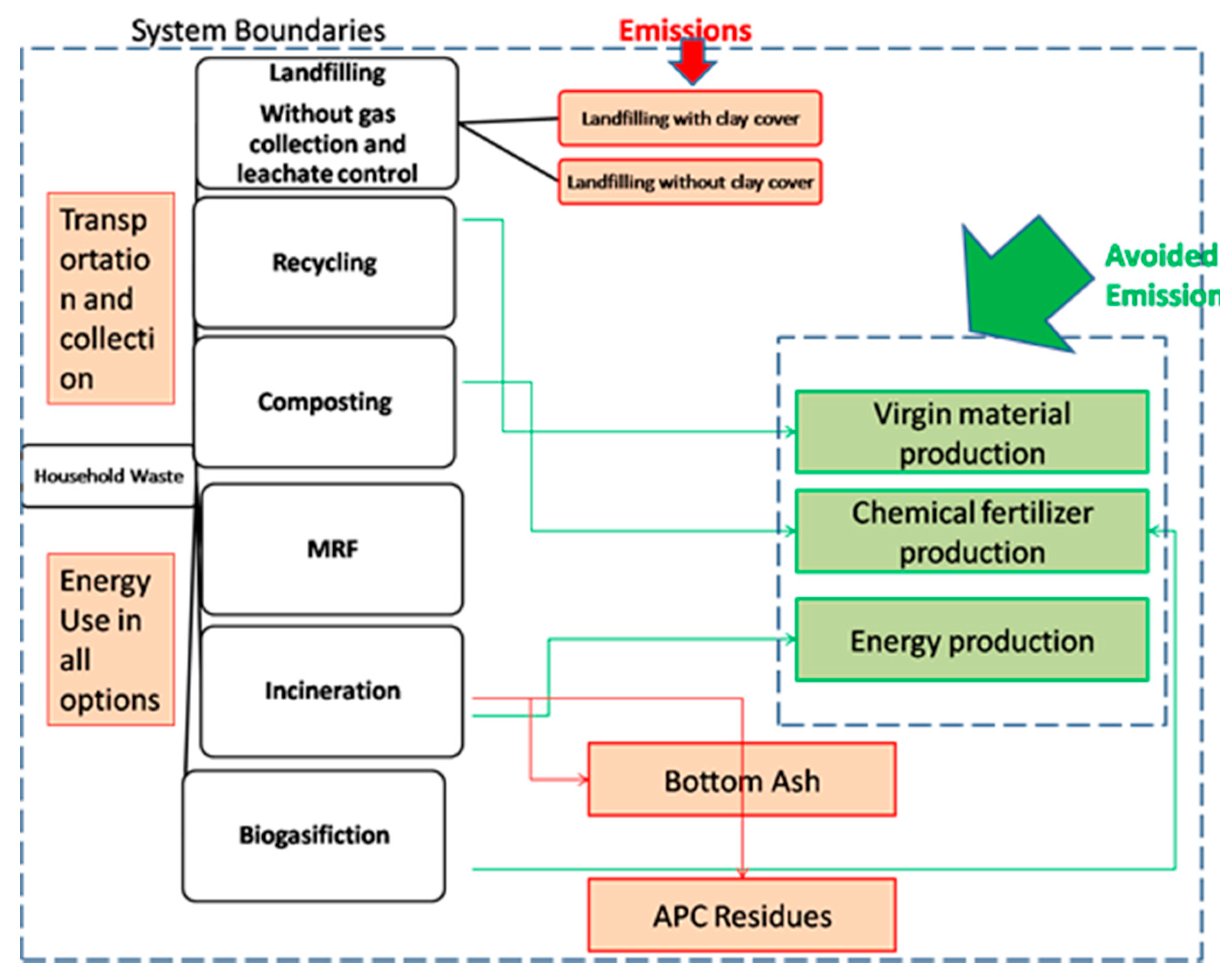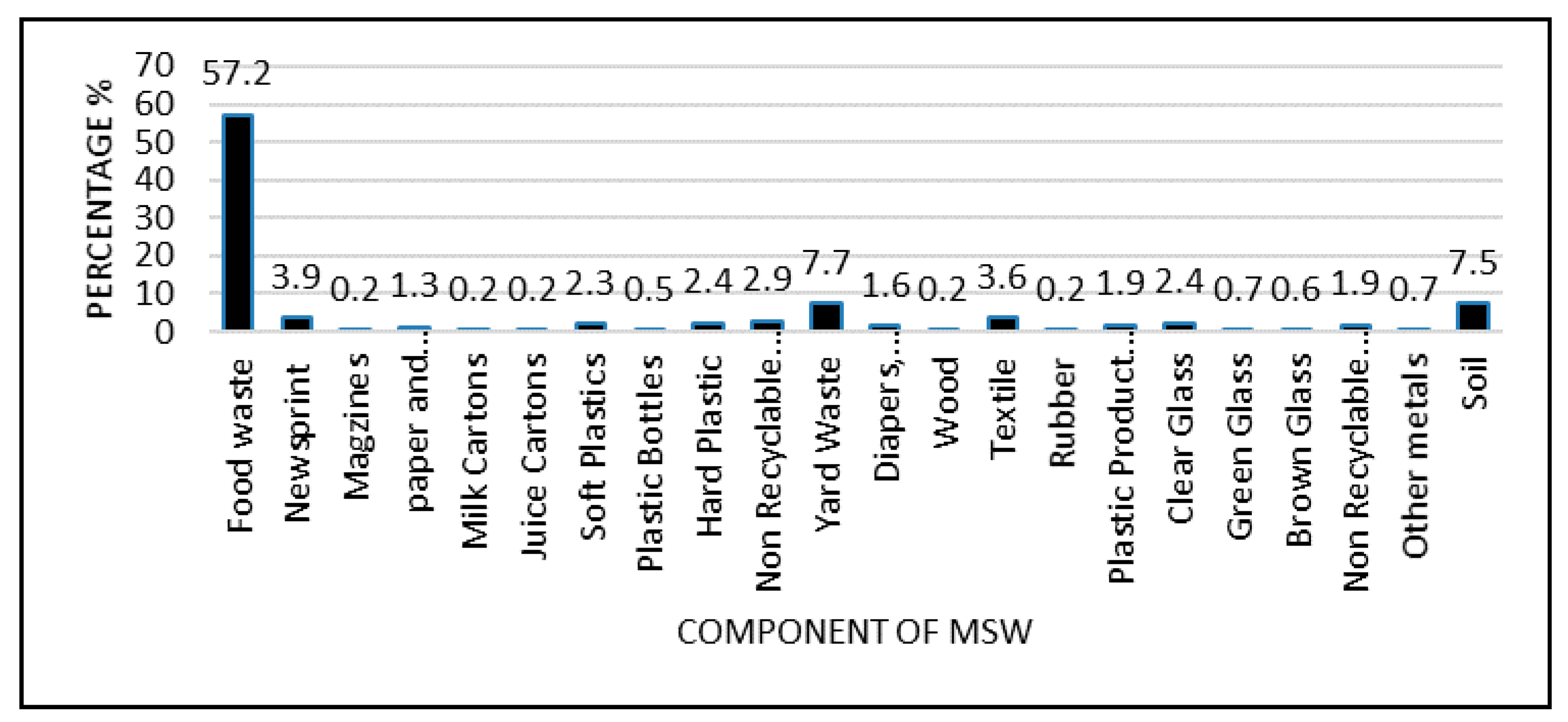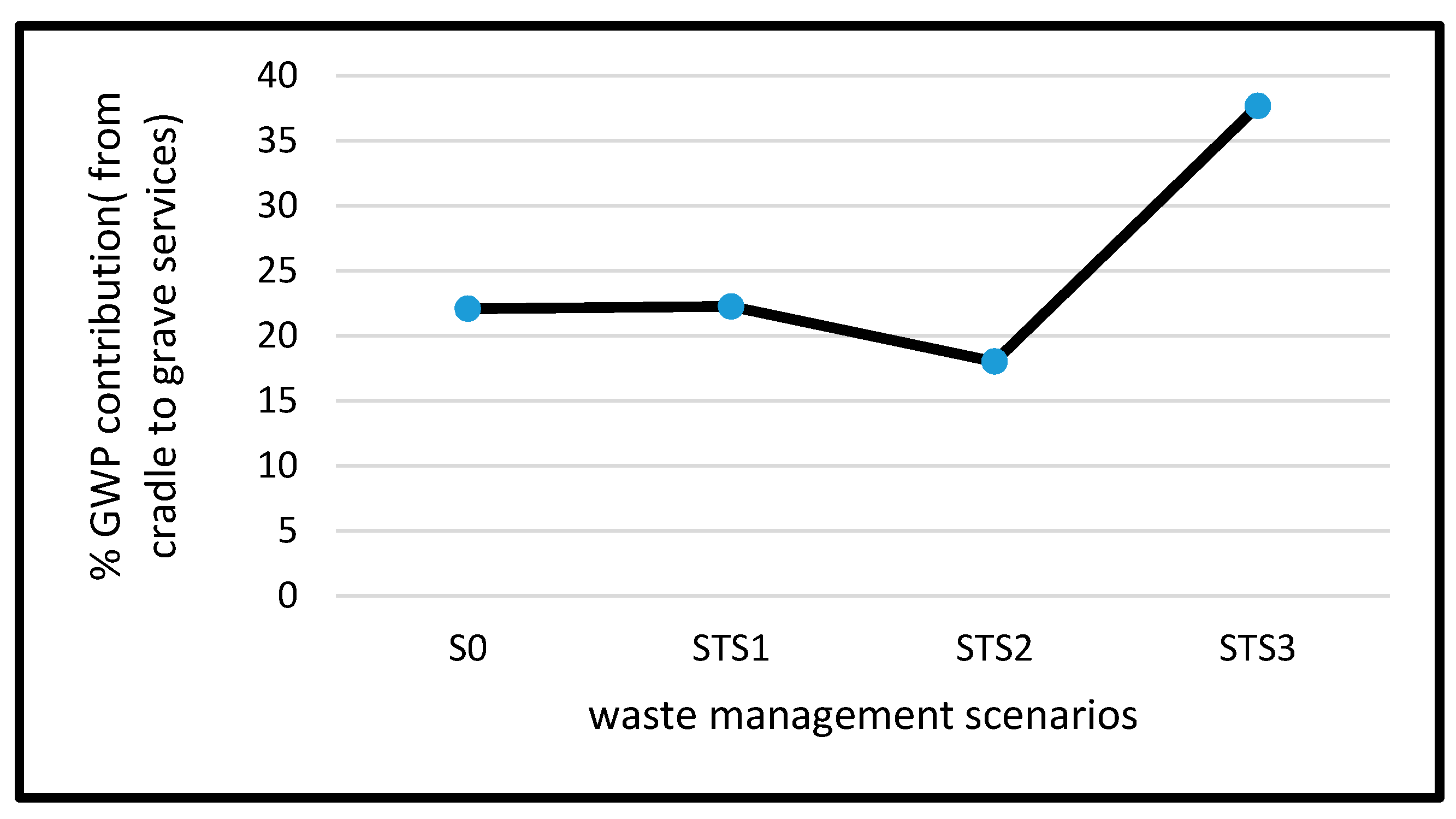Life Cycle Assessment Modelling of Greenhouse Gas Emissions from Existing and Proposed Municipal Solid Waste Management System of Lahore, Pakistan
Abstract
:1. Introduction
2. Materials and Methods
3. Results and Discussion
4. Conclusions
Acknowledgments
Author Contributions
Conflicts of Interest
References
- Weber, G.; Calaf-Forn, M.; Puig-Ventosa, I.; Cabras, I.; D’Alisa, G. The role of environmental organisations on urban transformation: The case of waste management in Esporles (Mallorca). J. Clean. Prod. 2017, in press. [Google Scholar] [CrossRef]
- Acuff, K.; Kaffine, D.T. Greenhouse gas emissions, waste and recycling policy. J. Environ. Econ. Manag. 2013, 65, 74–86. [Google Scholar] [CrossRef]
- Assamoi, B.; Lawryshyn, Y. The environmental comparison of landfilling vs. incineration of MSW accounting for waste diversion. Waste Manag. 2012, 32, 1019–1030. [Google Scholar] [CrossRef] [PubMed]
- Aye, L.; Widjaya, E.R. Environmental and economic analyses of waste disposal options for traditional markets in Indonesia. Waste Manag. 2006, 26, 1180–1191. [Google Scholar] [CrossRef] [PubMed]
- Intergovernmental Panel on Climate Change (IPCC). Fourth Assessment Report Climate Change 2007; Synthesis Report; Intergovernmental Panel on Climate Change: Geneva, Switzerland, 2007. [Google Scholar]
- Bogner, J.; Pipatti, R.; Hashimoto, R.; Diaz, C.; Mareckova, K.; Diaz, L.; Kjeldsen, P.S.; Faaij, A.; Gao, Q.; Zhang, T.; et al. Mitigation of Global Greenhouse Gas Emissions from Waste: Conclusions and Strategies from the Intergovernmental Panel on Climate Change (IPCC) Fourth Assessment Report. Working Group III (Mitigation). Waste Manag. Res. 2008, 26, 11–32. [Google Scholar] [CrossRef] [PubMed]
- Jensen, M.B.; Møller, J.; Mønster, J.; Scheutz, C. Quantification of greenhouse gas emissions from a biological waste treatment facility. Waste Manag. 2017, 67, 375–384. [Google Scholar] [CrossRef] [PubMed]
- Chang, N.-B.; Qi, C.; Islam, K.; Hossain, F. Comparisons between global warming potential and cost-benefit criteria for optimal planning of a municipal solid waste management system. J. Clean. Prod. 2012, 20, 1–13. [Google Scholar] [CrossRef]
- Friedrich, E.; Trois, C. Quantification of greenhouse gas emissions from waste management processes for municipalities—A comparative review focusing on Africa. Waste Manag. 2011, 31, 1585–1596. [Google Scholar] [CrossRef] [PubMed]
- Friedrich, E.; Trois, C. GHG emission factors developed for the collection, transport and landfilling of municipal waste in South African municipalities. Waste Manag. 2013, 33, 1013–1026. [Google Scholar] [CrossRef] [PubMed]
- Habib, K.; Schmidt, J.H.; Christensen, P. A historical perspective of Global Warming Potential from Municipal Solid Waste Management. Waste Manag. 2013, 33, 1926–1933. [Google Scholar] [CrossRef] [PubMed]
- He, L.; Huang, G.H.; Lu, H. Greenhouse gas emissions control in integrated municipal solid waste management through mixed integer bilevel decision-making. J. Hazard. Mater. 2011, 193, 112–119. [Google Scholar] [CrossRef] [PubMed]
- Oyoo, R.; Leemans, R.; Mol, A.P.J. Comparison of environmental performance for different waste management scenarios in East Africa: The case of Kampala City, Uganda. Habitat Int. 2014, 44, 349–357. [Google Scholar] [CrossRef]
- Wang, Y.; Yan, Y.; Chen, G.; Zuo, J.; Yan, B.; Yin, P. Effectiveness of waste-to-energy approaches in China: From the perspective of greenhouse gas emission reduction. J. Clean. Prod. 2017, 163, 99–105. [Google Scholar] [CrossRef]
- Couth, R.; Trois, C.; Parkin, J.; Strachan, L.J.; Gilder, A.; Wright, M. Delivery and viability of landfill gas CDM projects in Africa—A South African experience. Renew. Sustain. Energy Rev. 2011, 15, 392–403. [Google Scholar] [CrossRef]
- Liu, Y.; Sun, W.; Liu, J. Greenhouse gas emissions from different municipal solid waste management scenarios in China: Based on carbon and energy flow analysis. Waste Manag. 2017, 68, 653–661. [Google Scholar] [CrossRef] [PubMed]
- Talyan, V.; Dahiya, R.P.; Anand, S.; Sreekrishnan, T.R. Quantification of methane emission from municipal solid waste disposal in Delhi. Resour. Conserv. Recycl. 2007, 50, 240–259. [Google Scholar] [CrossRef]
- Björklund, A.; Finnveden, G. Recycling revisited—Life cycle comparisons of global warming impact and total energy use of waste management strategies. Resour. Conserv. Recycl. 2005, 44, 309–317. [Google Scholar] [CrossRef]
- Cleary, J. Life cycle assessments of municipal solid waste management systems: A comparative analysis of selected peer-reviewed literature. Environ. Int. 2009, 35, 1256–1266. [Google Scholar] [CrossRef] [PubMed]
- Kim, M.-H.; Song, Y.-E.; Song, H.-B.; Kim, J.-W.; Hwang, S.-J. Evaluation of food waste disposal options by LCC analysis from the perspective of global warming: Jungnang case, South Korea. Waste Manag. 2011, 31, 2112–2120. [Google Scholar] [CrossRef] [PubMed]
- Kim, M.-H.; Kim, J.-W. Comparison through a LCA evaluation analysis of food waste disposal options from the perspective of global warming and resource recovery. Sci. Total Environ. 2010, 408, 3998–4006. [Google Scholar] [CrossRef] [PubMed]
- Houghton, R.A.; Hackler, J.L. Carbon flux to the atmosphere from landuse changes. In In Trends: A Ompendium of Data on Global Change; Oak Ridge National Laboratory: Oak Ridge, TN, USA, 2002. [Google Scholar]
- Jadoon, A.; Batool, S.A.; Chaudhry, M.N. Assessment of factors affecting household solid waste generation and its composition in Gulberg Town, Lahore, Pakistan. J. Mater. Cycles Waste Manag. 2014, 16, 73–81. [Google Scholar] [CrossRef]
- Houghton, J.T.; Ding, Y.; Griggs, D.J.; Noguer, M.; van der Linden, P.J.; Dai, X.; Maskell, K.; Johnson, C.A. Climate Change 2001: The Scientific Basis; Earthprint Ltd.: Stevenage, UK, 2001. [Google Scholar]
- United Nations (UN). United Nations Framework Convention on Climate Change; United Nations: New York, NY, USA, 1992. [Google Scholar]
- United Nations (UN). Kyoto Protocol to the United Nations Framework Convention on Climate Change; United Nations: New York, NY, USA, 1997. [Google Scholar]
- Harvey, D. Global Warming the Hard Science; Dorling Kindersley: Agra, India, 2010. (In Indian) [Google Scholar]
- Kirkeby, J.T.; Birgisdottir, H.; Bhander, G.S.; Hauschild, M.; Christensen, T.H. Modelling of environmental impacts of solid waste landfilling within the life-cycle analysis program EASEWASTE. Waste Manag. 2007, 27, 961–970. [Google Scholar] [CrossRef] [PubMed]
- Knowles, R. Denitrifiers associated with methanotrophs and their potential impact on the nitrogen cycle. Ecol. Eng. 2005, 24, 441–446. [Google Scholar] [CrossRef]
- Mandernack, K.W.; Kinney, C.A.; Coleman, D.; Huang, Y.S.; Freeman, K.H.B.J. The biogeochemical controls of N2O production and emission in landfill cover soils: The role of methanotrophs in the nitrogen cycle. Environ. Microbiol. 2000, 2, 298–309. [Google Scholar] [CrossRef] [PubMed]
- Valasi, G.D.; Uqaili, M.A.; Memon, R.H.; Samoo, S.R.; Mirjat, N.H.; Harijan, K. Overcoming electricity crisis in Pakistan: A review of sustainable electricity options. Renew. Sustain. Energy Rev. 2017, 72, 734–745. [Google Scholar] [CrossRef]





| Substance Name | S0 | STS 1 | STS 2 | STS 3 |
|---|---|---|---|---|
| Carbon Dioxide (CO2—Biological with impact) | −352,093 | −352,093 | ||
| Carbon Sequestered | −54,572,532 | −53,068,261 | −53,068,261 | |
| HCFC 21 (Dichlorofluoromethane) | 75,627 | 75,627 | 75,184 | 444 |
| 1,1,1-Trichloroethane | 693 | 682 | 681 | 659 |
| Hydrocarbons (HC) | −176,051 | −176,262 | −180,207 | −176,631 |
| Carbon Monoxide (CO) | −264,323 | −264,692 | −270,280 | −270,923 |
| Carbon Dioxide (CO2—Fossil) | −58,836,893 | −58,965,960 | −80,709,327 | 258,009,697 |
| Methane (CH4) | 250,206,040 | 250,332,345 | 246,710,315 | −9,675,849 |
| Nitrous Oxide (Laughing Gas) (N2O) | 952,067 | 921,994 | −2,031,752 | 1,659,785 |
| Dichloromethane (Methylene chloride) | 15,005 | 15,005 | 14,917 | 88 |
| CFC 11 (Trichlorofluoromethane) | 1,380,497 | 1,380,497 | 1,372,399 | 8098 |
| CFC 12 (Dichlorodifluoromethane) | 6,362,288 | 6,362,288 | 6,324,968 | 37,320 |
| HFC 134a (Tetrafluoroethane) | 3 | 3 | 3 | 3 |
| HCFC 22 (Chlorodifluoromethane) | 663,239 | 663,239 | 659,348 | 3890 |
| Carbon tetrachloride | 1621 | 1621 | 1611 | 10 |
| CFC 113 (Trichlorotrifluoroethane) | 180,065 | 180,065 | 179,009 | 1056 |
| Halon (1301) | −744 | −870 | −870 | −744 |
| Total | 145,986,601 | 147,105,226 | 119,077,738 | 249,244,808 |
© 2017 by the authors. Licensee MDPI, Basel, Switzerland. This article is an open access article distributed under the terms and conditions of the Creative Commons Attribution (CC BY) license (http://creativecommons.org/licenses/by/4.0/).
Share and Cite
Syeda, A.B.; Jadoon, A.; Nawaz Chaudhry, M. Life Cycle Assessment Modelling of Greenhouse Gas Emissions from Existing and Proposed Municipal Solid Waste Management System of Lahore, Pakistan. Sustainability 2017, 9, 2242. https://doi.org/10.3390/su9122242
Syeda AB, Jadoon A, Nawaz Chaudhry M. Life Cycle Assessment Modelling of Greenhouse Gas Emissions from Existing and Proposed Municipal Solid Waste Management System of Lahore, Pakistan. Sustainability. 2017; 9(12):2242. https://doi.org/10.3390/su9122242
Chicago/Turabian StyleSyeda, Adila Batool, Anwar Jadoon, and Mahuammad Nawaz Chaudhry. 2017. "Life Cycle Assessment Modelling of Greenhouse Gas Emissions from Existing and Proposed Municipal Solid Waste Management System of Lahore, Pakistan" Sustainability 9, no. 12: 2242. https://doi.org/10.3390/su9122242
APA StyleSyeda, A. B., Jadoon, A., & Nawaz Chaudhry, M. (2017). Life Cycle Assessment Modelling of Greenhouse Gas Emissions from Existing and Proposed Municipal Solid Waste Management System of Lahore, Pakistan. Sustainability, 9(12), 2242. https://doi.org/10.3390/su9122242




